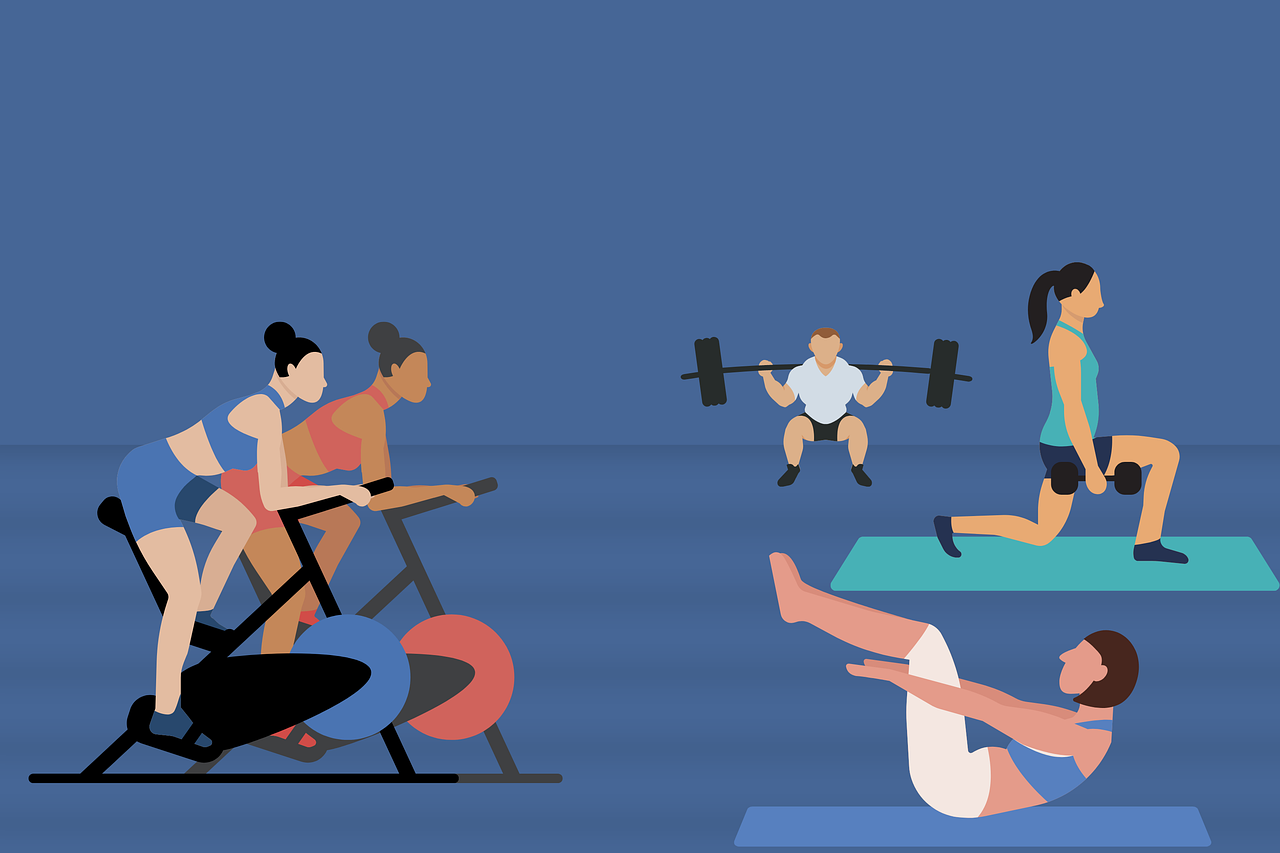Table of Contents
- 1 Introduction
- 2 The Science Behind the Link
- 3 Impact of Physical Activity on Mental Health Conditions
- 4 Types of Physical Activity and Their Mental Health Benefits
- 5 Exercise Recommendations for Mental Health
- 6 Barriers to Exercise and Overcoming Them
- 7 The Future of Physical Activity and Mental Health
- 8 Conclusion
![]()
Introduction
The relationship between physical activity and mental health is a critical area of study in modern healthcare. While physical exercise is widely acknowledged for its benefits on physical health, its impact on mental well-being is just as significant. Numerous studies have shown that engaging in regular physical activity can help prevent, manage, and even treat a variety of mental health conditions, including depression, anxiety, stress, and cognitive decline. Understanding this connection is vital not only for improving the quality of life but also for promoting overall mental well-being.
The Science Behind the Link
Biological Mechanisms
Physical activity influences mental health through a variety of biological processes, particularly involving the brain and hormonal systems.
- Neurotransmitter Regulation: Exercise promotes the release of key neurotransmitters such as serotonin, dopamine, and endorphins. These chemicals play a crucial role in regulating mood, reducing feelings of anxiety and depression, and increasing overall feelings of happiness and well-being.
- Brain Plasticity: Regular exercise stimulates neuroplasticity, which is the brain’s ability to form new neural connections. This process is essential for cognitive function, emotional regulation, and resilience. It can lead to improvements in memory, learning, and overall brain health, helping individuals better manage stress and emotional challenges.
- Hormonal Effects: Physical activity helps regulate cortisol, the body’s primary stress hormone. High levels of cortisol can contribute to anxiety and depression, but exercise helps to lower cortisol levels, leading to improved stress management and emotional stability.
Psychological Mechanisms
Exercise doesn’t just have biological effects; it also promotes significant psychological benefits.
- Self-Efficacy: Regular physical activity boosts an individual’s sense of self-efficacy— the belief in one’s ability to handle challenges. This sense of accomplishment from setting and achieving fitness goals translates into better coping skills for managing life’s challenges.
- Mood Improvement: Physical activity is known to increase self-esteem and reduce negative thoughts, particularly in people who experience mental health conditions like depression and anxiety. By fostering a sense of achievement, physical activity helps individuals develop healthier and more positive emotional patterns.
Social and Environmental Mechanisms
The social aspects of physical activity also contribute to its positive impact on mental health.
- Social Interaction: Many forms of exercise, particularly team sports and group fitness classes, provide opportunities for social interaction. Social connections and support networks are essential for maintaining mental health, as they provide a sense of belonging and reduce feelings of isolation.
- Exposure to Nature: Outdoor physical activities, such as walking or cycling in natural environments, have been linked to improved mental health. Spending time in nature has been shown to reduce stress, anxiety, and depression, providing a natural and calming environment for mental restoration.
Impact of Physical Activity on Mental Health Conditions
Depression
Exercise has long been recognized as a powerful tool for combating depression. It is thought to work by increasing the levels of mood-boosting neurotransmitters and by providing a structured activity that can help break the cycle of negative thinking.
- Exercise as an Antidepressant: Research has shown that physical activity is as effective as antidepressant medications in some cases, especially when combined with therapy. Aerobic exercises like running, cycling, and swimming are particularly beneficial, as they help alleviate symptoms of depression by promoting the release of endorphins, known as the “feel-good” hormones.
- Evidence and Studies: Studies consistently show that exercise improves mood and reduces depressive symptoms. For example, a study published in the American Journal of Preventive Medicine found that regular exercise could reduce the risk of depression by as much as 30%.
Anxiety
Physical activity can significantly reduce anxiety symptoms by helping the body relax and by diverting the mind from worry and stress.
- Reducing Anxiety Through Exercise: Exercise reduces the physiological symptoms of anxiety, such as rapid heart rate and shallow breathing, by stimulating the parasympathetic nervous system, which helps the body relax.
- Types of Exercise Effective for Anxiety: Aerobic exercises, yoga, and strength training have all been found to reduce anxiety. Yoga, in particular, is beneficial for anxiety due to its combination of physical movement and deep breathing techniques, which activate the body’s relaxation response.
Stress
Exercise is a well-known stress reliever. Physical activity helps manage stress by reducing cortisol levels and promoting relaxation.
- Physical Activity as a Stress Reducer: Exercise allows individuals to release pent-up tension, which can reduce feelings of stress. It also promotes better sleep, which in turn helps with stress recovery.
- Managing Chronic Stress: For individuals dealing with chronic stress, engaging in regular exercise can enhance the body’s ability to cope with stressors. Long-term physical activity helps improve resilience, making it easier to bounce back from difficult situations.
Cognitive Function and Mental Clarity
Regular physical activity has been shown to improve cognitive function, which is essential for maintaining mental clarity.
- Improvement in Cognitive Performance: Exercise enhances memory, focus, and attention by improving blood flow to the brain and increasing the production of growth factors involved in brain function.
- Preventing Cognitive Decline: Studies show that exercise helps prevent age-related cognitive decline. Older adults who engage in regular physical activity are less likely to develop neurodegenerative diseases like Alzheimer’s or dementia, and if they do, exercise can slow the progression of the disease.
Types of Physical Activity and Their Mental Health Benefits
Aerobic Exercise
Aerobic activities such as running, swimming, and cycling are particularly effective for improving mental health.
- Cardio Activities: Aerobic exercise has been shown to alleviate symptoms of depression and anxiety, increase energy levels, and improve overall mood. Studies suggest that engaging in regular cardio activity for at least 30 minutes most days of the week can significantly boost mental health.
- Endurance and Mental Health: Endurance-based activities not only improve physical health but also help to develop mental resilience. Overcoming physical challenges in activities like long-distance running can build confidence and improve one’s ability to handle mental and emotional stress.
Strength Training
Strength training, which includes weightlifting and resistance exercises, has also been linked to improved mental health.
- Muscle Building and Mental Health: In addition to improving physical strength, weight training can also enhance mood, increase self-esteem, and promote a sense of accomplishment.
- Reducing Anxiety and Depression: Research has shown that strength training can reduce symptoms of both anxiety and depression. The sense of progress and achievement that comes from improving physical strength can have a positive impact on psychological well-being.
Mind-Body Exercises
Mind-body practices, such as yoga and Pilates, offer both physical and mental health benefits.
- Yoga and Pilates: These exercises promote relaxation, increase flexibility, and reduce stress. Yoga, in particular, has been shown to reduce anxiety, depression, and symptoms of PTSD. The focus on breathwork and mindfulness in yoga helps individuals achieve a calm and centered state, reducing emotional reactivity.
- Tai Chi and Qigong: These gentle, flowing movements are beneficial for reducing stress and promoting emotional balance. Like yoga, tai chi and qigong focus on controlled breathing, making them excellent exercises for mental clarity and emotional well-being.
Team Sports and Social Activities
Engaging in team sports or group exercise classes can be especially beneficial for mental health.
- Social Interaction in Group Sports: Team sports foster a sense of community, which is essential for mental well-being. The social interactions and teamwork involved in sports can reduce feelings of isolation and boost mood.
- Community and Connection: Group fitness classes, running clubs, or even recreational sports leagues provide a sense of connection that contributes to improved mental health. These activities help individuals feel supported and part of a larger group, reducing loneliness.
Exercise Recommendations for Mental Health
Guidelines for Effective Exercise
To reap the mental health benefits of physical activity, it’s important to follow certain guidelines.
- Frequency and Duration: Experts recommend at least 150 minutes of moderate-intensity exercise per week for optimal mental health benefits. This can be broken down into 30-minute sessions, five days a week.
- Intensity Levels: Moderate to vigorous physical activity is most effective for boosting mood and reducing symptoms of mental health disorders. However, even light physical activity, such as walking, can offer benefits for mental well-being.
Individualized Exercise Plans
Exercise plans should be tailored to each person’s specific mental health needs.
- Tailoring Exercise to Mental Health Needs: For those dealing with depression, aerobic exercises may be most beneficial, while individuals with anxiety may find yoga and mindfulness-based activities to be more effective.
- Incorporating Physical Activity into Daily Routine: Small changes, such as taking the stairs instead of the elevator, walking or biking instead of driving, or scheduling regular walks, can help individuals incorporate more physical activity into their daily routines.
Exercise and Comorbidity
Many individuals face multiple mental health conditions simultaneously, and exercise can help address more than one issue at a time.
- Managing Multiple Conditions: For example, someone dealing with both depression and anxiety may benefit from a combination of aerobic exercise and mindfulness practices like yoga.
- Exercise as Part of a Holistic Treatment Plan: Exercise should be seen as part of an integrated treatment plan that includes therapy, medication, and other lifestyle changes. Combining physical activity with mental health treatment can improve overall outcomes.
Barriers to Exercise and Overcoming Them
Common Barriers
Several factors can prevent individuals from engaging in physical activity regularly, particularly when dealing with mental health challenges.
- Time Constraints: Busy schedules, family obligations, and work responsibilities often make it difficult to prioritize exercise.
- Lack of Motivation: Mental health issues like depression can reduce motivation, making it hard for individuals to find the energy or desire to exercise.
- Physical Limitations: Chronic pain, injury, or other physical conditions can limit an individual’s ability to participate in certain types of exercise.
Strategies for Overcoming Barriers
- Setting Realistic Goals: Setting small, achievable exercise goals can help build momentum and make physical activity feel less overwhelming.
- Building a Support System: Having a workout buddy, joining a fitness class, or participating in online fitness communities can provide the necessary support and motivation to stay active.
- Making Exercise Enjoyable: Finding activities that are fun and engaging can help ensure long-term adherence to an exercise routine.
The Future of Physical Activity and Mental Health
Research and Emerging Trends
- New Discoveries in Exercise Science: Ongoing research is uncovering more about how physical activity impacts mental health. New findings may lead to more personalized and targeted exercise interventions for specific mental health conditions.
- Technological Innovations: The rise of fitness trackers, apps, and virtual fitness platforms makes it easier for individuals to track their progress and stay engaged with their exercise routines.
Public Health Initiatives
- Government and Community-Based Programs: Public health campaigns and community programs can play a key role in encouraging physical activity as part of a healthy lifestyle, particularly in promoting mental health.
Conclusion
The connection between physical activity and mental health is undeniable. Regular exercise provides a multitude of benefits, from improving mood and reducing anxiety to enhancing cognitive function and managing stress. Despite barriers such as time constraints and lack of motivation, integrating physical activity into daily life is a powerful tool for improving mental health. As research continues, the importance of exercise in mental health care will only grow, helping individuals lead healthier, more fulfilling lives.
Share This





Be the first to comment